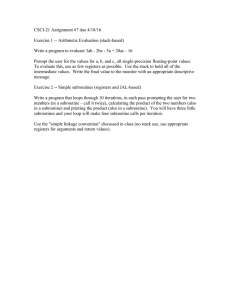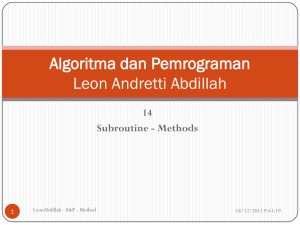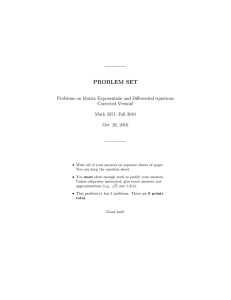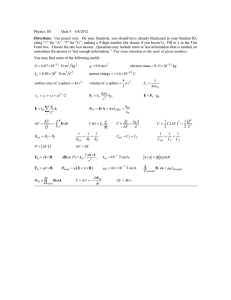Program 1 Shooting Method Description of the Method
advertisement
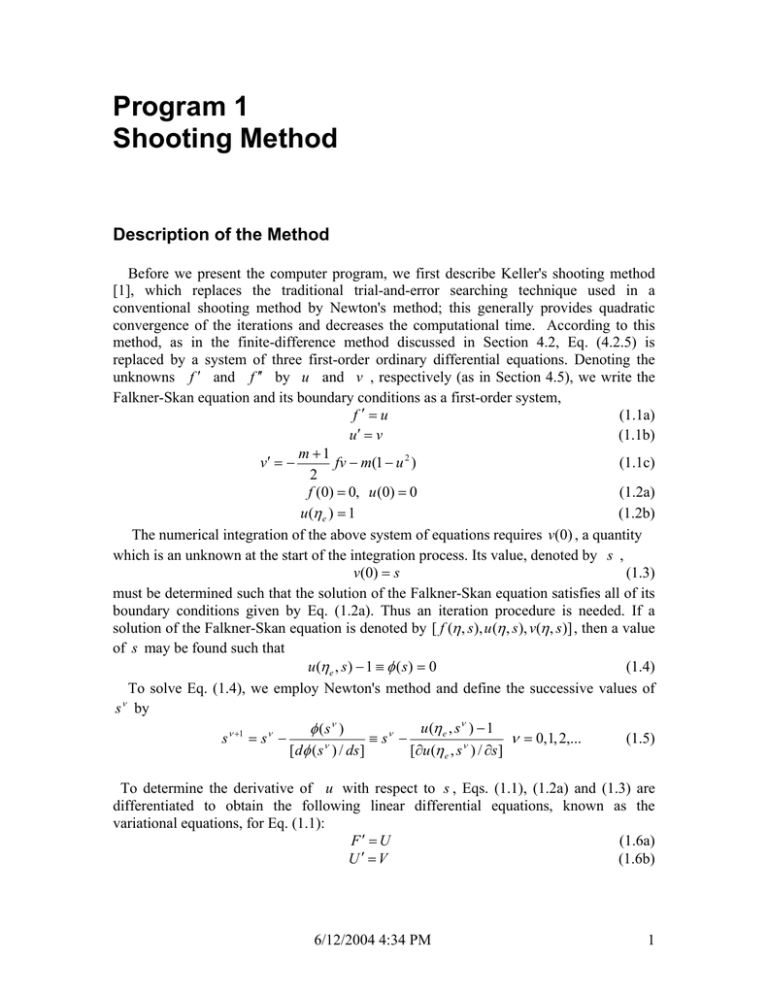
Program 1 Shooting Method Description of the Method Before we present the computer program, we first describe Keller's shooting method [1], which replaces the traditional trial-and-error searching technique used in a conventional shooting method by Newton's method; this generally provides quadratic convergence of the iterations and decreases the computational time. According to this method, as in the finite-difference method discussed in Section 4.2, Eq. (4.2.5) is replaced by a system of three first-order ordinary differential equations. Denoting the unknowns f ′ and f ′′ by u and v , respectively (as in Section 4.5), we write the Falkner-Skan equation and its boundary conditions as a first-order system, f′=u (1.1a) u′ = v (1.1b) m +1 v′ = − fv − m(1 − u 2 ) (1.1c) 2 f (0) = 0, u (0) = 0 (1.2a) u (η e ) = 1 (1.2b) The numerical integration of the above system of equations requires v(0) , a quantity which is an unknown at the start of the integration process. Its value, denoted by s , v(0) = s (1.3) must be determined such that the solution of the Falkner-Skan equation satisfies all of its boundary conditions given by Eq. (1.2a). Thus an iteration procedure is needed. If a solution of the Falkner-Skan equation is denoted by [ f (η , s ), u (η , s ), v(η , s )] , then a value of s may be found such that u (η e , s ) − 1 ≡ φ ( s ) = 0 (1.4) To solve Eq. (1.4), we employ Newton's method and define the successive values of ν s by u (η e , sν ) − 1 φ ( sν ) ν +1 ν ν s =s − ≡s − ν = 0,1, 2,... (1.5) [dφ ( sν ) / ds ] [∂u (η e , sν ) / ∂s ] To determine the derivative of u with respect to s , Eqs. (1.1), (1.2a) and (1.3) are differentiated to obtain the following linear differential equations, known as the variational equations, for Eq. (1.1): F′ = U (1.6a) ′ U =V (1.6b) 6/12/2004 4:34 PM 1 V′ = − and the initial conditions, m +1 ( fV + vF ) + 2muU 2 F (0) = 0, U (0) = 0, V (0) = 1 (1.6c) (1.7) Here ∂f ∂u ∂v (1.8) , U (η , s) ≡ , V (η , s) ≡ ∂s ∂s ∂s Once a solution of the Falkner-Skan equation is obtained subject to Eqs. (1.2a) and (1.3), and a solution of the variational equations (1.6), subject to Eqs. (1.7), u (η e , sν ) and F (η , s ) ≡ U (η e , sν ) is known, then the next approximation to v(0) , namely sν +1 can be computed from Eq. (1.5). The solution procedure is repeated until convergence when | sν +1 − sν |< ε (1.9) where ε is a convergence parameter. Computer Program We now describe the computer program for solving the Falkner-Skan equation for a specified value of m using the shooting method discussed above. While several integration methods can be used to solve the initial value problem, here, because of its simplicity, a fourth-order Runge-Kutta method is used. The computer program consists of a main program containing the logic of the computations which has three subroutines: STNDRD, VARS and RKM. The following is a description of the computer program and its subroutines. MAIN Contains the input data, the boundary-layer grid, the logic of the numerical scheme, the number of iterations performed, and the output, which consists of the profiles f , u , v as a function of η and the dimensionless displacement and momentum thickness parameters δ 1∗ and θ1 , respectively ηe δ 1∗ = ∫ (1 − f ′)dη = η e − f e 0 ηe θ1 = ∫ f ′(1 − f ′)dη 0 The input data are similar to the input data described for the finite-difference boundary-layer method BLP2 in Program 3, with NXT, ITMAX, ∆ X, S(1), ETAINF, EPS corresponding to the total number of x -stations, maximum iteration number, ∆η increment, v(0) = S (1) , η e and convergence criterion, which is usually taken as 10 −5 or 10 −6 . 6/12/2004 4:34 PM 2 Program Main C PROGRAM MAIN COMMON/SHARE/F(101),U(101),V(101),PNX1,NP,DX,NX,ETA(101),P(15), 1 S(15),PHI,ETAINF,DERWRS C-------------------------------------------------------------------C INPUT READ(5,8000) NXT,ITMAX,DX,S(1),ETAINF,EPS READ(5,8100) (P(I),I=1,NXT) C TOTAL NUMBER OF GRID POINTS, NP NP = ETAINF/DX +1.1 NX = 1 C INITIAL VALUE OF INDEPENDENT VARIABLE 60 ETA(1) = 0.0 WRITE(6,9300) NX,P(NX),S(NX) WRITE(6,9050) IT = O PNX1 = -0.5*(P(NX)+1.0) C 90 IT = IT+1 IF (IT .LE. ITMAX) GO TO 95 WRITE(6,9000) GO TO 400 C 95 CALL STNDRD CALL VARS TERM = PHI/DERWRS WRITE(6,9060) S(NX),TERM S(NX) = S(NX)-TERM C C CHECK FOR CONVERGENCE IF (ABS(TERM) .GT. EPS) GO TO 90 CALL STNDRD S(NX+1) = S(NX) C OUTPUT 400 WRITE(6,9070) DO 2 J=1,NP,8 2 WRITE(6,9100) J,ETA(J),F(J),U(J),V(J) DELST1 = ETA(NP) - F(NP) THETA1 = (S(NX)-P(NX)*DELST1)/(1.5*P(NX)+0.5) WRITE(6,9200) DELST1,THETA1 C NX = NX+1 IF (NX .LE. NXT .AND. IT .LE. ITMAX) GO TO 60 STOP C---------------------------------------------------------------8000 FORMAT(2I3,4F10.0) 8100 FORMAT(F10.0) 9000 FORMAT(1H ,25HITERATIONS EXCEED MAXIMUM) 9050 FORMAT(1H ,11X,1HS,13X,3H-DS) 9060 FORMAT(1H ,5X,2E14.6) 9070 FORMAT(1H ,2X,1HJ,4X,3HETA,9X,1HF,13X,1HU,13X,1HV/) 9100 FORMAT(1H ,I3,F10.4,4E14.6) 9200 FORMAT(1H ,7HDELST1=,E14.6,3X,7HTHETA1=,E14.6//) 9300 FORMAT(1H ,3HNX=,I3,5X,2HP=,F10.6,5X,2HS=,F10.6) END 6/12/2004 4:34 PM 3 Subroutine STNDRD STDRD Defines the boundary and initial conditions given by Eqs. (1.2a) and (1.3) at the wall and the system of equations given by Eq. (1.1). Also, s in Eq. (1.4a) is computed. SUBROUTINE STNDRD COMMON/SHARE/F(101),U(101),V(101),PNX1,NP,DX,NX,ETA(101),P(15), 1 S(15),PHI,ETAINF,DERWS DIMENSION C(3),B(3),Z(3),G(12) C-------------------------------------------------------------------C DEFINITION OF FIRST-ORDER SYSTEM C INITIAL VALUES OF DEPENDENT VARIABLES N = 3 X = 0.0 IS = 0 B(1) = 0.0 B(2) = 0.0 B(3) = S(NX) F(1) = B(1) U(1) = B(2) V(1) = B(3) C DO 100 J=2,NP DO 110 LL=1,4 C(1) = B(2) C(2) = B(3) C(3) = PNX1*B(1)*B(3)-P(NX)*(1.0-B(2)**2) 110 CALL RKM(X,B,C,DX,N,Z,G,IS) C C SAVE CURRENT VALUES F(J) = B(1) U(J) = B(2) V(J) = B(3) 100 ETA(J) = X PHI = U(NP)-1.0 RETURN END Subroutine VARS VARS Defines the variational equations and their initial conditions given by Eqs. (1.6) and (1.7). U (η e , sν ) in Eq. (1.5) is computed here. SUBROUTINE VARS COMMON/SHARE/F(101),U(101),V(101),PNX1,NP,DX,NX,ETA(101),P(15), 1 S(15),PHI,ETAINF,DERWRS DIMENSION C(3),B(3),Z(3),G(12) C-------------------------------------------------------------------C INITIAL VALUES OF DEPENDENT VARIABLES 6/12/2004 4:34 PM 4 N = 3 X = 0.0 IS = 0 B(1) = 0.0 B(2) = 0.0 B(3) = 1.0 FF = F(1) UU = U(1) VV = V(1) C SOLUTION FOR GIVEN F,FP,FPP PROFILES DO 100 J=2,NP FJ = F(J) UJ = U(J) VJ = V(J) DO 10 LL=1,4 GO TO (4,2,4,3),LL 2 FF = (FF+FJ)/2.0 UU = (UU+UJ)/2.0 VV = (VV+VJ)/2.0 GO TO 4 3 FF = FJ UU = UJ VV = VJ 4 C(1) = B(2) C(2) = B(3) C(3) = PNX1*(VV*B(1)+FF*B(3))+2.0*P(NX)*B(2)*UU 10 CALL RKM(X,B,C,DX,N,Z,G,IS) 100 CONTINUE C DERWRS = B(2) RETURN END Subroutine RKM RKM contains the Runge-Kutta method, which is of fourth order in ∆η . It integrates any system of first-order quasi-linear simultaneous ordinary differential equations and is not specialized to the Falkner-Skan system. To describe this method, consider a firstorder differential equation of the form dy = f ( x, y ) (1.10) dx subject to the prescribed initial condition y = y0 when x = x0 . According to the commonly used fourth-order Runge-Kutta method, the solution of Eq. (4A.10) is given by 1 yn+1 = yn + (k1 + 2k2 + 2k3 + k4 ) (1.11) 6 where, with h = xn+1 − xn = ∆x , 6/12/2004 4:34 PM 5 k1 = hf ( x n , y n ) k 2 = hf ( x n + 12 h, y n + 12 k1 ) k 3 = hf ( x n + 12 h, y n + 12 k 2 ) k 4 = hf ( x n + h, y n + k 3 ) (1.12) Thus, in each step in (or x ), RKM must be called four times. The arguments X to IS have the following explanation. • The independent variable . The initial value for X must be input. • A floating point array that is dimensioned N . The B(I ) are the current values of the dependent variables. For example, f B (1) u = B ( 2) v B (3) Initial values f (0) , u0 , and v(0) must be input. DX A floating point array that is dimensioned N . The ( CI ) are the current values of derivatives. These values are supplied to RKM through the argument list. For example, F C (1) U = C (2) V C (3) DX N F The increment in . DX must be input The number of simultaneous equations to be integrated. A floating point array used by the subroutine to store values of the array B . F is dimensioned N . A floating array that contains intermediate values computed by the subroutine. Four entries of G are used to compute one entry of B . G is dimensioned 4 ∗ N . A code variable that must be set to zero to initialize the subroutine. IS is automatically stepped through the values 1, 2, 3 and 4 and is reset to zero by the subroutine after user variables for X and the array B are computed. The four entries to RKM are, in effect, four improved estimates of the required integral over the interval DX . G IS SUBROUTINE RKM(A,B,C,DX,N,F,G,IS) DIMENSION C(N),B(N),F(N),G(4*N) C-------------------------------------------------------------------IS = IS+1 GO TO (10,30,60,80), IS C FIRST ENTRY 10 E = A DO 20 I=1,N 6/12/2004 4:34 PM 6 F(I) = B(I) G(4*I-3) = C(I)*DX 20 B(I) = F(I)+G(4*I-3)/2.0 GO TO 50 C SECOND ENTRY 30 DO 40 I=1,N G(4*I-2) = C(I)*DX 40 B(I) = F(I)+G(4*I-2)/2.0 50 A = E+DX/2.0 GO TO 100 C THIRD ENTRY 60 DO 70 I=1,N G(4*I-1) = C(I)*DX 70 B(I) = F(I)+G(4*I-1) A = E+DX GO TO 100 C FOURTH ENTRY 80 DO 90 I=1,N G(4*I) = C(I)*DX B(I) = G(4*I-3)+2.0*(G(4*I-2)+G(4*I-1)) 90 B(I) = (B(I)+G(4*I))/6.0+F(I) IS = 0 100 RETURN END Applications To demonstrate the applications of the computer program and its output, we present results for Blasius similar flow m = 0 , which corresponds to NXT = 1 . We take ITMAX = 6 , ∆η -increment (DX) 0.1, wall shear (1) at NX = 1 as 0.300, η e as 8 and convergence parameter as 10 −6 . The output presented below shows that the profiles f j , u j , v j as functions of η j and j together with the rate of convergence of the solutions and dimensionless boundary-layer parameters δ 1∗ and θ1 for each value of m . The results for m = 0 show that, for an assumed wall shear value of 0.3, the rate of convergence of the solutions in quadratic, requiring only three iterations. To obtain solutions for m = 0.5 , we have used increments of ∆m = 0.1 . Again, the convergence rate is quadratic. Similar results are also obtained for m = 1 . Results are only presented for m = 0 , 0.5 and 1.0. NX= 1 J P= 0.000000 S= 0.300000 S -DS 0.300000E+00 -0.315214E-01 0.331521E+00 -0.537911E-03 0.332059E+00 -0.296956E-07 ETA F U 1 0.0000 0.000000E+00 0.000000E+00 6/12/2004 4:34 PM V 0.332059E+00 7 9 0.8000 0.106109E+00 0.264711E+00 0.327391E+00 17 1.6000 0.420323E+00 0.516760E+00 0.296665E+00 25 2.4000 0.922295E+00 0.728986E+00 0.228093E+00 33 3.2000 0.156910E+01 0.876086E+00 0.139128E+00 41 4.0000 0.230576E+01 0.955522E+00 0.642340E-01 49 4.8000 0.308534E+01 0.987794E+00 0.218711E-01 57 5.6000 0.388031E+01 0.997482E+00 0.543197E-02 65 6.4000 0.467938E+01 0.999616E+00 0.980645E-03 73 7.2000 0.547925E+01 0.999960E+00 0.128584E-03 81 8.0000 0.627924E+01 0.100000E+01 0.122445E-04 DELST1= 0.172075E+01 THETA1= 0.664119E+00 NX= 1 J P= 0.500000 S= 0.817270 S -DS 0.817270E+00 -0.899329E-01 0.907203E+00 0.746350E-02 0.899739E+00 0.226980E-04 0.899717E+00 -0.125888E-06 ETA F U V 1 0.0000 0.000000E+00 0.000000E+00 0.899717E+00 9 0.8000 0.245793E+00 0.563205E+00 0.516792E+00 17 1.6000 0.827465E+00 0.852277E+00 0.227309E+00 25 2.4000 0.156199E+01 0.963375E+00 0.716724E-01 33 3.2000 0.234773E+01 0.993629E+00 0.154319E-01 41 4.0000 0.314556E+01 0.999247E+00 0.220024E-02 49 4.8000 0.394534E+01 0.999941E+00 0.203881E-03 57 5.6000 0.474532E+01 0.999997E+00 0.122146E-04 65 6.4000 0.554532E+01 0.100000E+01 0.554850E-06 73 7.2000 0.634532E+01 0.100000E+01 0.910765E-07 81 8.0000 0.714532E+01 0.100000E+01 0.688662E-07 DELST1= 0.854673E+00 THETA1= 0.377904E+00 NX= J 1 P= 1.000000 S= 1.173530 S -DS 0.117353E+01 -0.175270E+00 0.134880E+01 0.756893E-01 0.127311E+01 0.327164E-01 0.124039E+01 0.742014E-02 0.123297E+01 0.387354E-03 0.123259E+01 0.581049E-06 ETA F U V 1 0.0000 0.000000E+00 0.000000E+00 0.123259E+01 9 0.8000 0.312424E+00 0.685937E+00 0.525132E+00 17 1.6000 0.979781E+00 0.932347E+00 0.147353E+00 25 2.4000 0.175525E+01 0.990548E+00 0.260216E-01 33 3.2000 0.255233E+01 0.999185E+00 0.275514E-02 41 4.0000 0.335211E+01 0.999957E+00 0.168261E-03 49 4.8000 0.415210E+01 0.999997E+00 0.519110E-05 57 5.6000 0.495210E+01 0.999998E+00 -0.660768E-06 65 6.4000 0.575210E+01 0.999997E+00 -0.864673E-06 73 7.2000 0.655210E+01 0.999997E+00 -0.934394E-06 81 8.0000 0.735209E+01 0.999996E+00 -0.109396E-05 DELST1= 0.647902E+00 THETA1= 0.292342E+00 6/12/2004 4:34 PM 8 Source Code, input data and test cases 6/12/2004 4:34 PM 9


